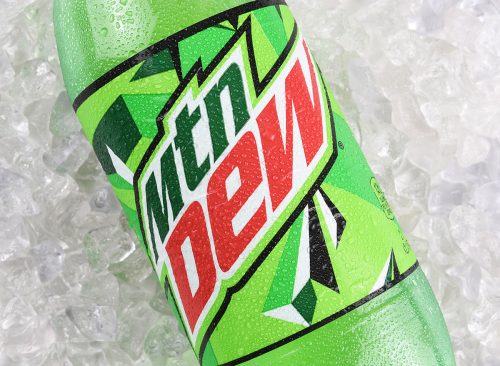Murder Suspect Soaked in Mountain Dew to Erase DNA
Florida woman doused self in soda to erase DNA after murder, say police.

Aside from drinking it out of the can or bottle, there are a number of things you can do with Mountain Dew. For example, you can make a mixed drink, bake a cake with it, or even use it to marinate meat. One Florida woman even thought that dousing herself in the sugary, citrus soft drink can even help erase DNA after you commit a crime, authorities claim. The police have proved her theory wrong. Here is what you need to know about the wacky new case out of the Sunshine State.

Authorities maintain that Nichole Maks, 35, killed her 79-year-old roommate. And according to the arrest affidavit, after she did the deed, she doused herself in soda in hopes of eliminating any evidence.

On July 1, a Daytona Beach police officer was flagged down by a citizen regarding a fire at a home in the 600 block of Clark Street in the early hours of the morning. Firefighters arrived at the scene and put out the fire.

They also found a man lying on the floor dead with blunt force trauma to the back of his head and multiple stab wounds to his torso, the affidavit stated. The man was later identified as 79-year-old Michael Cerasoli. They also found a bloody knife in the victim’s bedroom near his body and blood on the wall next to Mak’s bedroom closet. Maks was listed as a person of interest, and officers attempted to locate her. She was found

They located Maks at Krystal’s restaurant around 3:30 a.m. with no shoes on and blood on the side of her leg, per the affidavit. Part of her shirt was torn off and had blood on it. She was carrying a knife and hammer, which she dropped when approached by officers.

They questioned her, and she changed her story many times. She claimed she was homeless and didn’t know the victim and also denied carrying the knife and hammer. Later she confessed to being his roommate, but became “agitated” when asked about the fire and requested an attorney.

Officers told her they would be collecting her DNA. While walking to the patrol car, she asked for a drink. The officers handed her a Diet Mountain Dew. She procrastinated drinking it, and when the officer tried to take it, she doused her body and hair with the drink. She also began “pulling and kicking officers.”

The DNA from the Florida Department of Law Enforcement (FDLE) for the knife found next to the victim matched Maks, and the DNA on Maks’ knife matched the victim’s. She entered a written plea of not guilty on all charges last week, and on Sunday, her attorney requested that a doctor examine her to determine her mental competence to stand trial.

DNA profiling, also known as DNA fingerprinting, has been a vital tool in the criminal justice system since the late 1980s. Dr. Michael Coble, a forensic scientist, explains to The Conversation that human DNA is remarkably similar, with up to 99.9% identical genetic makeup across individuals. However, around 98% of our DNA is non-coding, with sequences of the four DNA bases that form the structure of DNA. Interestingly, certain sections of these sequences are repeated. For instance, a sequence like TCTA might be repeated five times. While this repetition is consistent within one person, it can vary among individuals. This variation forms the foundation of modern DNA profiling.

Dr. Coble, quoted by The Conversation, clarifies that the key to DNA profiling lies in the detection of these repeated sequences, technically referred to as “short tandem repeats” or STRs. Initially, in 1994, the UK Forensic Science Service identified four such regions, and this has expanded over time to encompass 24 STR regions. When examining all known STR regions, the probability of two random individuals sharing the same DNA profile becomes infinitesimally small. To perform DNA profiling, a sample with sufficient DNA is needed. This could come from sources as diverse as blood, hair, saliva, or skin. Even a tiny amount, like 500 picograms (equivalent to around 80 cells), can suffice.

Dr. Coble emphasizes that DNA profiling is highly sensitive and can work with minute amounts of DNA. However, scenarios arise where the DNA comes from multiple sources. In cases like a knife handled by two people, if only 80 cells are present, the DNA profile may represent a mixture of both individuals. Software exists to untangle mixed DNA profiles, but incomplete or partial profiles might result. Insufficient DNA could lead to ambiguous or erroneous results. Additionally, with extremely small DNA amounts, there’s the possibility of “indirect transfer,” where DNA is present due to secondary contact. These complexities underline the limitations of DNA profiling, which, while potent in identifying the source of biological material, cannot uncover every detail or context surrounding its presence.
RELATED: 30 Area Codes to Watch for in Latest Phone Scam

In conclusion, DNA profiling’s strength lies in answering the question “whose biological material is this?” Its ability to discern the contributor of genetic material has revolutionized forensic investigations. Yet, the technique has inherent constraints, especially when dealing with mixed DNA or minuscule samples. The journey from identifying DNA to uncovering the complete narrative behind its presence involves a combination of techniques and methods beyond the scope of DNA profiling alone.














